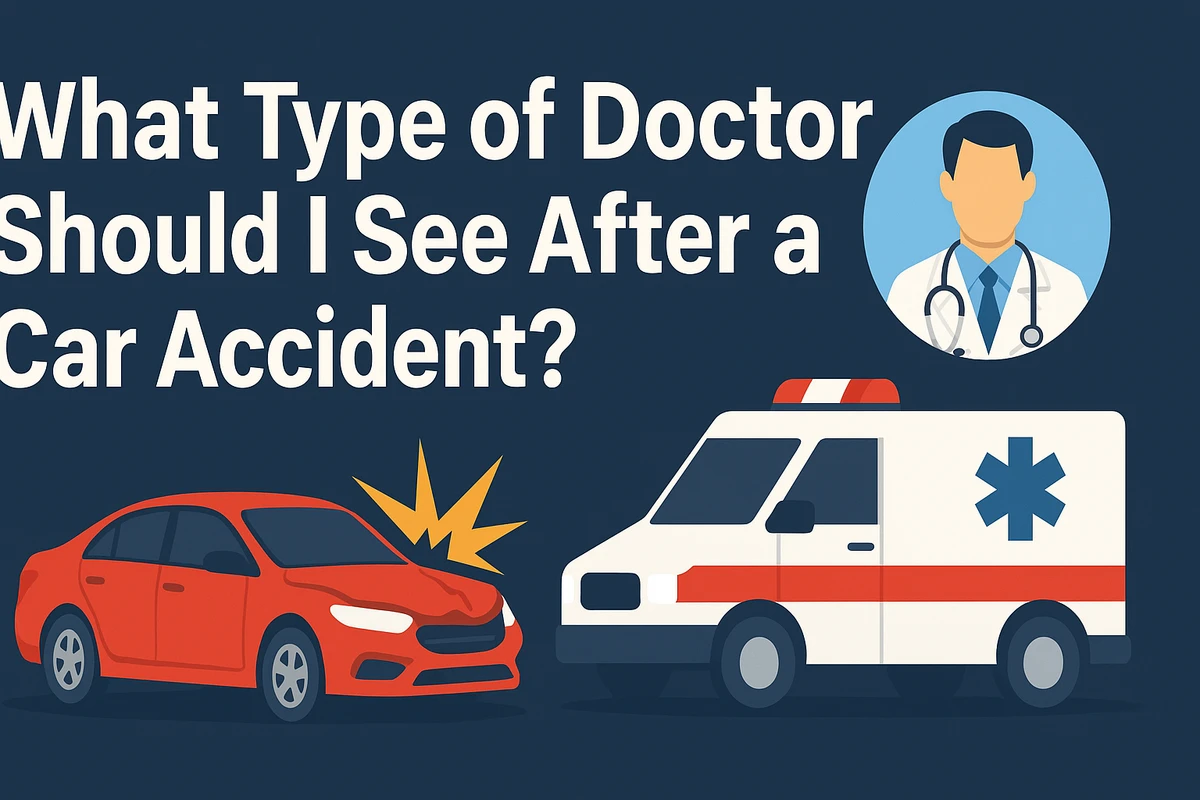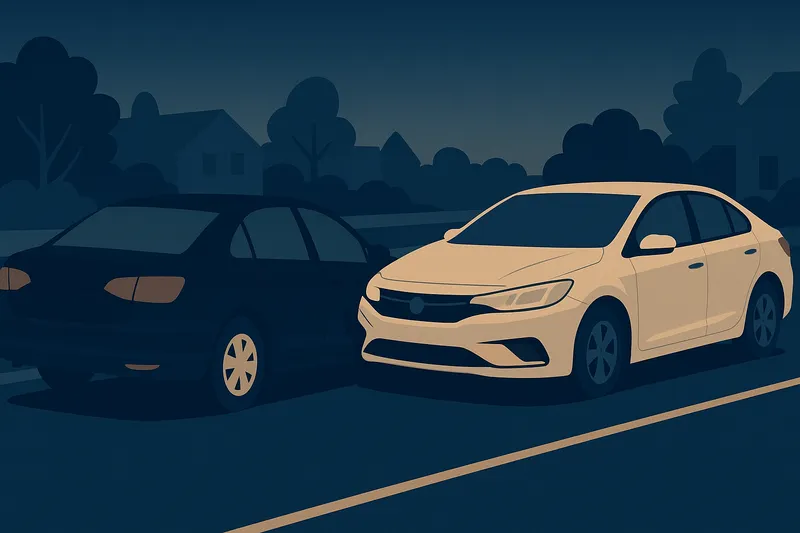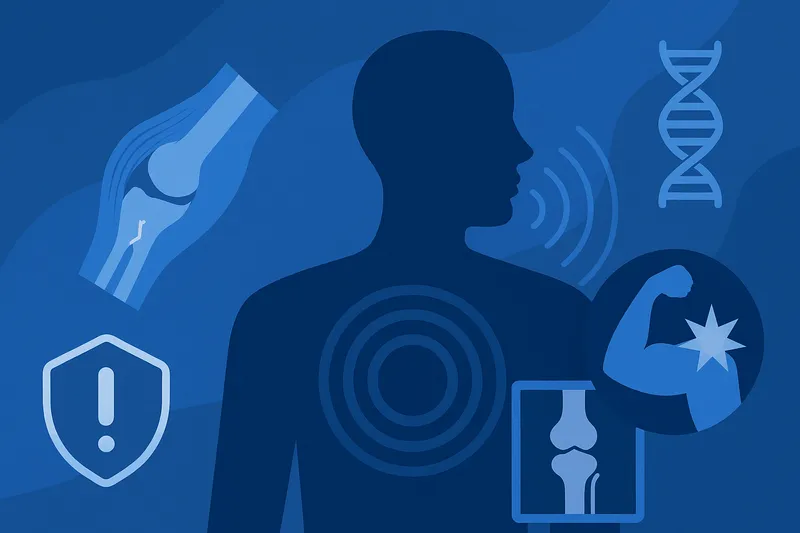What Type of Doctor Should You See After a Car Accident?

Published: 4/4/2025
After a car accident, getting prompt medical attention is crucial. Even if you feel fine at first, some injuries can be hidden or show symptoms later.
Common Injuries After a Car Accident
Car accidents can be frightening and confusing. In the aftermath, you may not realize you’re injured right away – the rush of adrenaline and shock can mask pain and symptoms. Some injuries (like whiplash or concussions) might not fully manifest until hours or days later. That’s why it’s important to see a doctor as soon as possible after a crash. Prompt medical evaluation ensures you get proper treatment and also creates documentation linking your injuries to the accident, which is vital if you need to file an insurance or legal claim. This article will guide you through the common injuries caused by car accidents, the recommended sequence of medical care (from emergency services to specialists), the importance of documenting medical visits, and which doctor to see based on your symptoms.
Even low-speed fender benders can cause injuries. Here are some of the most common injuries car accident victims experience:
-
Whiplash (Neck Strain/Sprain): Whiplash is a common neck injury, especially in rear-end collisions. It happens when your head is violently whipped forward and backward, stretching or tearing the neck’s muscles and ligaments. Symptoms of whiplash include neck pain, stiffness, headaches (often at the base of the skull), and sometimes pain in the shoulders or arms. This is a type of soft tissue injury that may not cause symptoms immediately but can become very painful in the days after the accident.
-
Soft Tissue Injuries (Bruises, Sprains, Strains): Soft-tissue injuries refer to damage of muscles, ligaments, or tendons throughout the body. Common examples are bruises (contusions), muscle sprains and strains, or torn ligaments from the sudden force of impact. These injuries can result in pain, swelling, tenderness, and limited mobility while they heal. Often, soft tissue damage is not visible on X-rays, but you will feel the effects in the form of soreness or reduced range of motion. If you do have bruises, remember to take photos of them for documentation.
-
Back Pain and Spinal Injuries: The impact of a crash can jolt your back and spine. People frequently experience mid-back or lower back pain after accidents due to muscle strains or herniated discs (when a spinal disk is pushed out of place). More serious spinal injuries can involve nerve damage; for example, a pinched nerve from a herniated disc might cause tingling or numbness in your arms or legs. In severe cases, trauma to the spine can even result in spinal cord injury or paralysis – though those are less common. Any persistent back pain or radiating pain/numbness after an accident should be evaluated by a medical professional.
-
Broken Bones (Fractures): The force of a collision can lead to broken bones. It’s common to see fractures in the arms, legs, ribs, or collarbone in moderate to severe crashes. More serious accidents can even cause fractures in the spine or skull. Broken bones usually cause acute pain, swelling, and inability to move the affected limb or area. They often require emergency treatment for proper alignment, which might include casts, splints, or even surgery in the case of complex fractures.
-
Concussions (Traumatic Brain Injury): A concussion is a mild form of traumatic brain injury that can occur if you hit your head or if your brain is shaken within your skull during the crash. For instance, striking your head on the steering wheel or window can cause a concussion. Symptoms of a concussion include headaches, dizziness, nausea, confusion, memory problems, or blurred vision. Even a “mild” concussion is serious – if you have any signs of a concussion, you should see a doctor right away. In fact, any head injury from a car accident warrants prompt medical attention, as more severe brain injuries (like bleeding or swelling in the brain) need emergency treatment.
(Note: Car accidents can also cause internal injuries (like internal bleeding or organ damage) which may not be obvious from the outside. If you have abdominal pain or feel faint, those could be signs of internal injury requiring emergency care. Additionally, accidents are traumatic events, and some people experience emotional injuries such as anxiety or post-traumatic stress – in such cases, seeking help from a mental health professional is advisable. This article, however, will focus on physical injuries and medical care.)*
Emergency Room vs. Urgent Care: Getting Immediate Medical Help
Immediately after a car accident, assess how severe your injuries are. If there’s any chance you have a serious injury, don’t hesitate – get emergency medical care. Read our article on “Emergency Room vs. Urgent Care” for more details on when to go to the ER versus urgent care.
Seeing Your Primary Care Physician (PCP)
Once any immediate injuries are addressed, or if you decided the injuries were mild enough to skip the ER, your next step should be to see your primary care physician (PCP) or family doctor. Your PCP is the doctor who knows your health history and can provide a thorough check-up after the accident.
Here’s why seeing your PCP promptly is important:
Even if you feel “okay,” schedule an appointment with your doctor as soon as possible after the crash. Let the receptionist know it’s for a post-accident evaluation. During the visit, tell your doctor in detail what happened in the accident and describe any ache, pain, or odd symptom you have, even if it seems minor. This is not the time to downplay your pain – be honest and specific about what hurts or feels off. The doctor will perform a head-to-toe examination, check for tender areas, and possibly order tests (like X-rays or other scans) to make sure no injury is missed. An accurate diagnosis of all injuries ensures you receive proper treatment and helps you avoid complications later.
Treatment of Mild Injuries
Primary care doctors can treat many minor to moderate injuries themselves. They can clean and bandage wounds, remove glass fragments, prescribe medications for pain and inflammation, and give advice for home care (such as icing sore muscles or resting). For example, if you have whiplash or a mild back strain, your PCP might prescribe muscle relaxants or recommend over-the-counter pain relievers and rest. They will also monitor your symptoms in the coming days or weeks to see if you are improving.
Referrals to Specialists
One of the key roles of a primary doctor is to act as a gatekeeper for specialized care. If your physician finds a specific injury that needs expert attention – say, a suspected fracture, a concussion, or persistent numbness in a limb – they will refer you to the appropriate specialist for further evaluation. (For instance, they might refer a back injury to an orthopedic spine specialist or neurological symptoms to a neurologist.) Primary doctors commonly provide referrals to specialists, physical therapists, or chiropractors as needed. In many health insurance plans (especially HMOs), you must get a referral from your PCP before seeing a specialist, otherwise the specialist visit might not be covered. Make sure to follow through on any referral your doctor gives and attend those specialist appointments promptly.
Follow-Up and Continuity of Care:
After your initial post-accident visit, your PCP may schedule follow-ups to check on your healing progress. They will track improvements or any new issues, adjust medications if needed, and ensure that any specialist’s recommendations are integrated into your overall care. This continuity is important both for your health and for maintaining a clear record of treatment.
Note: Some primary care clinics are reluctant to treat car accident injuries or handle the billing through auto insurance. It’s not that they can’t treat you, but they may worry about insurance paperwork or potential legal involvement. In fact, it’s reported that many primary doctors will not see someone after a car accident for these reasons. If your regular doctor refuses to see you for accident-related care, don’t give up. In that case, go to an urgent care or seek out a clinic that specializes in accident injuries. You can also inform your auto insurance claim representative or attorney, if you have one, as they often know which local doctors accept accident cases. The bottom line is that you need medical attention – if one provider can’t see you, find another who will.
Specialists for Specific Injuries
After an accident, you might need care from a medical specialist depending on the type of injury. Specialists are doctors (or healthcare professionals) with advanced training in a particular field – for example, orthopedists focus on the musculoskeletal system, while neurologists focus on the nervous system. Typically, you would see a specialist after an initial evaluation (at the ER or by your primary doctor), and usually through a referral. Seeing a specialist at the right time can speed up your recovery by providing targeted treatment. Below are some common specialists accident victims may need to consult, and the kinds of symptoms or injuries that would lead you to them:
Orthopedic Specialists (Bone and Joint Doctors)
Orthopedic doctors deal with injuries to the bones, joints, and connective tissues (ligaments and tendons). If you broke a bone or suspect any kind of fracture, an orthopedic surgeon or doctor is the right specialist to treat you. They will confirm the break on X-ray or MRI and set the bone back in place (which might involve casting, bracing, or surgical fixation with pins/plates for severe breaks). Orthopedists also treat joint injuries (like a torn shoulder ligament from the seatbelt) and spinal injuries. For example, if you have ongoing neck pain or back pain after the accident (a possible sign of whiplash or a disc injury), your primary doctor might refer you to an orthopedic spine specialist. Orthopedic specialists can diagnose conditions with advanced imaging and recommend a treatment plan – this could include procedures like surgery or non-surgical options like injections and physical therapy. They also help manage your recovery of function. In short: see an orthopedist for broken bones, suspected fractures, serious sprains/tendon injuries, or persistent orthopedic pains.
(Example: After an X-ray confirms you have a fractured rib from the crash, you would follow up with an orthopedic doctor who can monitor the healing and advise you on activity restrictions. If you have whiplash that isn’t improving or severe back pain with nerve symptoms, an orthopedic spine specialist can evaluate you for disc injuries or spinal fractures. In some cases, orthopedists and neurologists work together – e.g. if a spine injury involves nerve issues, you might see both specialists.)*
Neurologists (Brain and Nerve Specialists)
Neurologists specialize in the nervous system – the brain, spinal cord, and nerves. You would be referred to a neurologist if you show signs of a head injury, concussion, spinal cord trauma, or nerve damage after the accident. Symptoms that indicate you may need a neurologist include: persistent headaches that won’t go away, frequent dizziness, memory problems or confusion, weakness in an arm or leg, numbness or tingling in your hands, feet, or down your limbs, or seizures. These could point to conditions like a concussion or traumatic brain injury (TBI), a pinched nerve, or other neurological issues. A neurologist can perform a thorough neurological exam and order specialized tests (such as an MRI of the brain or nerve conduction studies) to diagnose such conditions. For instance, if you suffered a concussion, the neurologist will assess the severity and monitor your brain function as you recover. They can also prescribe medications to manage symptoms (like headaches or nausea) and therapies to help restore cognitive function if needed. If you have a spinal cord injury, neurologists work alongside spine surgeons or rehabilitation doctors to manage it. In summary: see a neurologist for any head injury (especially if you blacked out or have concussion symptoms) or nerve-related symptoms (like numbness, tingling, weakness, or coordination problems) after a crash. Early evaluation is important, because untreated neurological injuries can worsen – for example, a minor brain injury could lead to long-term issues if not addressed.
(Example: You hit your head in the accident and a day later you’re feeling dizzy and nauseous with a pounding headache – your doctor would likely refer you to a neurologist to check for a concussion or other brain injury. Or, you have neck pain with shooting pains and numbness down your arm; this could mean a nerve in your neck is compressed, so a neurologist (or an orthopedic spine specialist) would be the right doctor to investigate and treat that nerve issue.)*
Chiropractors (Chiropractic Care for Muscles and Spine)
A chiropractor is a licensed healthcare professional (not an M.D., but a Doctor of Chiropractic) who focuses on the diagnosis and treatment of neuromuscular disorders, primarily through manual adjustment or manipulation of the spine. Chiropractic care is commonly sought after car accidents, especially for whiplash injuries, neck and back pain, and stiffness. If you’re dealing with ongoing musculoskeletal pain after the accident – for example, a sore neck that isn’t relieved by rest, or lower back pain – a chiropractor might help. They use hands-on techniques to adjust the alignment of your spine and joints, which can alleviate pressure on nerves and reduce pain and muscle tension. Common injuries treated by chiropractors include: whiplash, muscle strains in the neck or back, and minor misalignments in the spine from the impact. Chiropractic treatment is non-invasive (no surgery, no medication). It typically involves a series of adjustments, exercises, and stretches. The goal is to restore your range of motion, improve posture, and promote natural healing. Many accident victims find relief from pain through chiropractic care, especially in combination with physical therapy exercises.
However, it’s usually wise to get a medical doctor’s evaluation before seeing a chiropractor, to rule out fractures or serious structural injuries. Chiropractors don’t perform surgery, so if you have something like a herniated disc pressing on a nerve severely, you may need an orthopedic or neurosurgeon’s care instead (often, chiropractors will refer you out if they suspect something beyond their scope). In summary: you can consider seeing a chiropractor for persistent neck or back pain, soreness, or reduced mobility after an accident, particularly for whiplash injuries, once serious conditions have been ruled out. They will focus on relieving pain and improving alignment through spinal adjustments.
(Example: After being rear-ended, you have neck stiffness and headaches (classic whiplash symptoms). You visit a chiropractor who adjusts your cervical spine over a few sessions and provides exercises. This helps reduce your pain and restores mobility. If at any point the chiropractor finds something worrying – like signs of a slipped disc – they would advise you to see an orthopedic specialist. Many people use chiropractic care alongside standard medical treatment to address soft-tissue injuries.)
Physical Therapists (Rehabilitation Specialists)
Physical therapy (PT) is a critical component of recovery for many car accident injuries. Physical therapists are movement and rehabilitation experts (not medical doctors, but licensed clinicians) who help you regain strength, flexibility, and function after an injury. Often, after your immediate injuries are treated (by the ER, PCP, or specialists), you will be prescribed physical therapy to rehabilitate the affected body parts. For example, if you had a broken bone, once it’s healed enough, PT will help you restore normal movement in that limb. If you had a neck or back injury, PT can strengthen the muscles supporting your spine and improve your posture, reducing pain over time.
A physical therapist will design a personalized exercise program tailored to your injuries and recovery goals. This might include stretching exercises for flexibility, strengthening exercises for weakened muscles, and balance or coordination activities if needed. They might also use treatments like heat/cold therapy, massage, or electrical stimulation (TENS) to alleviate pain. The benefits of physical therapy include: improved recovery timeline, reduced risk of long-term complications (like chronic pain or stiffness), and help in returning to your normal daily activities and work. For instance, without PT, a person with a whiplash injury might heal slowly and develop chronic neck pain; with PT, they can often restore full function and prevent future issues.
Typically, your primary doctor, orthopedist, or neurologist will give you a referral for physical therapy if they believe it’s needed. It’s important to attend all your PT sessions and do any at-home exercises the therapist prescribes, as this significantly influences how well and how quickly you recover. In summary: see a physical therapist as part of your recovery plan if you have had any injury that limits your movement or causes weakness, such as neck/back injuries, broken bones, or soft tissue injuries. Physical therapy will help you safely rebuild strength and mobility under professional guidance.
(Example: You sustained a shoulder injury and whiplash in a crash. After initial treatment, your doctor prescribes 4 weeks of physical therapy. In PT, you work on exercises to loosen your neck and strengthen shoulder muscles. Over those weeks, your range of motion improves and your pain decreases, allowing you to get back to regular activities. Skipping PT could mean your shoulder stays weak or your neck heals in a stiff way, so sticking with therapy is very important.)*
The Importance of Documenting Medical Visits for Insurance and Legal Claims
While focusing on your health is the top priority, you should also keep in mind the paper trail of your medical care. Thorough documentation of all your medical visits and treatments after a car accident is critically important if you plan to file an insurance claim or a personal injury lawsuit. Here’s why:
Medical records serve as official evidence of what injuries you sustained and when. They link your injuries directly to the car accident. Insurance companies and courts will heavily rely on these records when determining compensation. For example, an emergency room record from the day of the crash that notes you had a sprained wrist and concussion is hard evidence that those injuries came from the accident. Without documentation, it becomes your word against the insurance company, which is not a strong position to be in.
If a doctor does not document your injuries or treatment properly, it can weaken your case. For instance, if you see a doctor weeks after the accident and they don’t note the connection to the crash, the insurance company may argue that your injuries were caused by something else. This is why it’s crucial to have a clear timeline of care that shows you sought treatment promptly after the accident.
Establishing Severity and Treatment Timeline
Your collection of medical reports, doctor’s notes, MRI/X-ray results, and prescriptions paints a picture of how severe your injuries are. Frequent visits to doctors and specialists, or recommendations for surgery or physical therapy, indicate that the injury significantly affected you. This can justify higher compensation for medical bills, lost wages, and even pain and suffering. On the other hand, gaps in treatment or long delays before seeking care can undermine your case. If you wait weeks to see a doctor, an insurance adjuster might argue that you must not have been very hurt, or that something else could have caused your injury. In fact, many insurance policies require prompt medical evaluation – failing to see a doctor soon after the crash might weaken your claim or even give the insurer a reason to deny parts of it.
Following Doctor’s Orders
It’s not enough just to go to the first appointment – you need to follow through with the treatment plan. Insurance companies look for consistency. If your physician recommends six sessions of physical therapy and you only do one, the insurer can argue you didn’t do your part to get better, which can reduce the value of your claim. Always follow instructions: take medications as prescribed, do therapy, and attend all follow-up visits. Not only does this improve your health outcome, it also shows that you are taking the injury seriously. Document each of these steps (keep receipts, appointment summaries, etc.).
Even if you feel better, don’t skip follow-up appointments. Your doctor needs to make note of your recovery. This will show the insurance company that all of the treatment was necessary and that you are following the doctor’s advice. If you stop going to the doctor, it can raise red flags for the insurance company. If you stop going to the doctor, the insurance company may claim you are no longer injured or that your injuries were not serious.
Practical tips: From day one, keep a file (physical or digital) of all documents related to your treatment. This includes hospital discharge papers, doctor visit summaries, test results, referral slips, prescription receipts, and even notes you jot down about symptoms or days missed from work. If you have to fill out accident-related forms, keep copies. Also, consider keeping a journal of your recovery – noting dates when symptoms worsened or improved, how the injuries affect your daily life, etc. This can be useful later on to refresh your memory and demonstrate the injury’s impact. Remember, if you don’t have a record of a medical visit or complaint, for the insurance company it’s almost as if it never happened.
Always remember, when in doubt, start with a medical professional you have access to – even if it’s not the “perfect” one.
If you walk into an urgent care or a doctor’s office and describe your symptoms, they will guide you to the right care either by treating you or referring you onward. The healthcare system is designed so that emergencies are handled in ERs, general issues by primary doctors, and specific problems by specialists. You don’t have to self-diagnose the exact injury; you just need to get to a doctor, and they will help figure out what’s wrong and who can fix it.
Take Care of Your Health First
Being involved in a car accident is stressful, but taking the right steps afterward can protect both your health and your rights. Seek medical care as soon as possible – even if injuries seem minor – because early treatment can prevent complications and uncover any hidden issues. Follow the recommended sequence: address emergencies at the ER, get follow-up care with your primary doctor, and see specialists or therapists for specific problems as needed. By doing so, you give yourself the best chance at a full recovery.
Throughout this process, document everything. Not only will keeping records strengthen any insurance or legal claim, it will also help your various healthcare providers coordinate your care. If you’re ever unsure which doctor to see, use your symptoms as a guide and don’t hesitate to ask a medical professional for guidance or a referral. Ultimately, the goal is to recover from your injuries and get back to normal life. By understanding which doctor to see for which issue, you can navigate the post-accident medical maze with more confidence and focus on healing, knowing you’re in good hands every step of the way.
If you have any questions about your injuries or the process of seeking medical care after a car accident, please reach out to us. Our Cumming auto accident lawyers have extensive experience helping clients navigate the aftermath of car accidents, including medical care and insurance claims.
Related Articles





